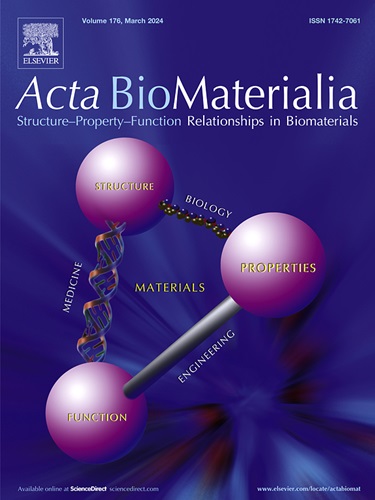Exploration of biomaterial-tissue integration in heterogeneous microporous annealed particle scaffolds in subcutaneous implants over 12 months
IF 9.4
1区 医学
Q1 ENGINEERING, BIOMEDICAL
引用次数: 0
Abstract
Microporous annealed particle (MAP) scaffolds are comprised of hydrogel microparticles with inter- and intra-particle cross-links that provide structure and cell-scale porosity, making them an increasingly attractive option for injectable tissue augmentation. Many current injectable biomaterials create a substantial foreign body response (FBR), while MAP scaffolds mitigate this response and have the potential to facilitate the formation of new tissue, though this de novo tissue formation is poorly understood. Here, we leverage a subcutaneous implant model to explore the maturation of MAP implants with and without heparin microislands (µislands) over one year to identify the effect of bioactive particles on scaffold maturation. Implants were measured and explanted after 1, 3, 6, and 12 months and analyzed using immunofluorescence staining and RNA-sequencing. No fibrous capsule or significant FBR was observed, and though a significant amount of MAP remains at 12 months, we still see a volume decrease over time. Heparin µislands facilitate increased cell infiltration and recruit a wider variety of cells at 1 month than blank MAP scaffolds, although this effect diminishes after 3 months. Transcriptomics reveal a potential activation of the complement-mediated immune response at 12 months in both groups, possibly associated with pore collapse in the implants. A single 12-month sample avoided this outcome, yielding complete cell infiltration, vascularization, and substantial matrix deposition throughout. Future work will characterize the effect of implantation site and facilitate increased matrix deposition to support the scaffold and prevent pore collapse.
Statement of significance
Injectable biomaterials are increasingly used clinically for soft tissue augmentation and regeneration but still face significant issues from the foreign body reaction. While some materials intentionally promote this response to stimulate collagen deposition, porous materials like MAP scaffolds can mitigate the immune response and allow for true tissue integration. However, this integration is poorly understood, particularly on long timescales, as traditional materials are dominated by inflammatory signals. In this work, we leverage a minimally inflammatory subcutaneous implant to investigate the maturation of MAP scaffolds with and without bioactive heparin-containing particles. The results presented here contribute a better understanding of the long-term material-tissue dynamics of MAP scaffolds that can inform future material design for tissue augmentation.
非均质微孔退火颗粒支架在皮下植入体中生物材料组织整合的探索。
微孔退火颗粒(MAP)支架由具有颗粒间和颗粒内交联的水凝胶微粒组成,提供结构和细胞尺度的孔隙度,使其成为可注射组织增强的越来越有吸引力的选择。目前许多可注射的生物材料会产生大量的异物反应(FBR),而MAP支架减轻了这种反应,并有可能促进新组织的形成,尽管人们对这种新生组织的形成知之甚少。在这里,我们利用皮下植入模型来探索有肝素微岛和没有肝素微岛(µislands)的MAP植入物在一年内的成熟情况,以确定生物活性颗粒对支架成熟的影响。分别在1、3、6、12个月后测量植入物并进行外植,采用免疫荧光染色和rna测序进行分析。没有观察到纤维囊或明显的FBR,尽管在12个月时仍有大量MAP,但我们仍然看到体积随着时间的推移而减少。与空白MAP支架相比,肝素岛在1个月时促进细胞浸润和募集更多种类的细胞,但这种作用在3个月后减弱。转录组学揭示了两组在12个月时补体介导的免疫反应的潜在激活,可能与植入物的孔塌陷有关。单个12个月的样本避免了这种结果,产生完整的细胞浸润、血管形成和大量基质沉积。未来的工作将描述植入部位的影响,并促进增加基质沉积以支持支架并防止孔隙坍塌。意义声明:可注射生物材料在临床上越来越多地用于软组织增强和再生,但仍然面临着来自异物反应的重大问题。虽然一些材料有意促进这种反应以刺激胶原沉积,但像MAP支架这样的多孔材料可以减轻免疫反应并允许真正的组织整合。然而,人们对这种整合知之甚少,特别是在长时间尺度上,因为传统材料主要由炎症信号控制。在这项工作中,我们利用低炎症的皮下植入物来研究MAP支架的成熟情况,这些支架有和没有生物活性的含肝素颗粒。本文提出的结果有助于更好地理解MAP支架的长期材料-组织动力学,可以为未来的组织增强材料设计提供信息。
本文章由计算机程序翻译,如有差异,请以英文原文为准。
求助全文
约1分钟内获得全文
求助全文
来源期刊

Acta Biomaterialia
工程技术-材料科学:生物材料
CiteScore
16.80
自引率
3.10%
发文量
776
审稿时长
30 days
期刊介绍:
Acta Biomaterialia is a monthly peer-reviewed scientific journal published by Elsevier. The journal was established in January 2005. The editor-in-chief is W.R. Wagner (University of Pittsburgh). The journal covers research in biomaterials science, including the interrelationship of biomaterial structure and function from macroscale to nanoscale. Topical coverage includes biomedical and biocompatible materials.
 求助内容:
求助内容: 应助结果提醒方式:
应助结果提醒方式:


